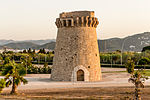Pego, Alicante

Pego (Valencian and Spanish: [ˈpeɣo]) is a municipality located in the province of Alicante, Spain. Lying just inland from the northern Costa Blanca resort of Dénia, the town of Pego sits in a depression, surrounded by mountains. A part of the Marina Alta comarca of Alicante, Pego has a population of 10,721 (2006) and a history dating from the Arab occupation. The region around Pego was settled during the Bronze Age and later by Iberian and Roman civilizations, though the story of the town really begins during the times of the Moors in around 726, when Pego was an important Arab enclave which later formed part of the Taifa of Dénia. Subsequently, conquered by forces under James I of Aragon in 1244, Pego was later repopulated with peasants from Catalonia and the barony of Pego was created in 1262, and control of the town passed through the hands of various members of the Valencian nobility.
Excerpt from the Wikipedia article Pego, Alicante (License: CC BY-SA 3.0, Authors, Images).Pego, Alicante
carrer Sant Lluís,
Geographical coordinates (GPS) Address Nearby Places Show on map
Geographical coordinates (GPS)
| Latitude | Longitude |
|---|---|
| N 38.841666666667 ° | E -0.11666666666667 ° |
Address
carrer Sant Lluís
carrer Sant Lluís
03780
Valencian Community, Spain
Open on Google Maps









